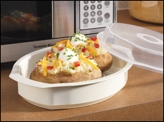Almost every American home has one. And many of us rely heavily on its convenience–the microwave oven. Some still remain skeptical, however, with a lingering feeling that microwave use somehow makes food less healthy. Is food cooked in the microwave harmful to our health? Does this cooking method remove nutrients from our food?
Researchers have explored the effect of various cooking methods on the nutritional content of vegetables and agree that whether you are zapping food in the microwave or cooking it on the stove, it is the amount of water used, the extent of the heat, and the cooking time all affect the nutritional value. Cooking vegetables in large amounts of water at high cooking temperatures for extended periods of time results in the loss of heat-sensitive and water-soluble vitamins. As a result, microwave cooking actually minimizes vitamin loss because the food cooks more quickly with minimal amounts of water.
In order to get the most from your vegetables and prevent the vitamines from escaping, follow these simple steps:
- Store produce in the refrigerator. Cool temperatures help preserve vitamins.
- Cut up vegetables just before cooking to decrease the amount of surface that is exposed to air.
- Steam, microwave, or stir-fry vegetables instead of boiling to reduce the time of heat exposure.
- Cook vegetables only until “crisp tender.” If they are “mush,” you can be sure there is not much nutritional value left.
There is no scientific evidence that microwave cooking makes our food harmful. Microwave ovens work by causing molecules in your food to vibrate. Specifically, the ovens emit waves that cause water molecules in the food to rotate. As they do so, the water molecules rub against one another, generating heat. Microwaves do not depend upon nuclear radiation, nor do they make food radioactive. Still not convinced? Click here for more information.
Another topic of concern has been the safety of reheating food in plastic containers. It is best to follow the manufacturer’s recommendations when using any plastic product in the microwave. Only use cookware that is specially manufactured for microwave use. Containers such as margarine tubs, take-out containers, whipped topping bowls, and other one-time use containers should not be used in microwave ovens. These containers can warp or melt, possibly causing harmful chemicals to leak into the food.
An important consideration with microwave use is proper techniques for thawing, cooking, and reheating to prevent bacterial overgrowth. For best results in both the quality and safety, consumers should follow the cooking instructions on product labels and observe “standing times,” if provided. For foods that do not have labeled cooking instructions, use the following temperature guidelines from the U.S. Department of Agriculture (USDA).
Since microwaves sometimes heat food unevenly, be sure these temperatures are reached in all parts of the meat:
- Steaks, roasts, and chops: 145° F
- Poultry: 165° F
- Ground poultry: 165° F
- Ground meats, all cuts of fresh pork, eggs, and egg dishes (i.e. casseroles, soufflés): 160° F
- Fish/seafood: 145° F
- Reheating leftovers: 165° F
No matter your cooking method of choice, start with the freshest of ingredients, make plant foods your base, and learn to appreciate the enjoyment of a wholesome, home-cooked meal with your family.
Written By: Julie Husmann, RD, CDE Holland Hospital’s Center for Good Health.




